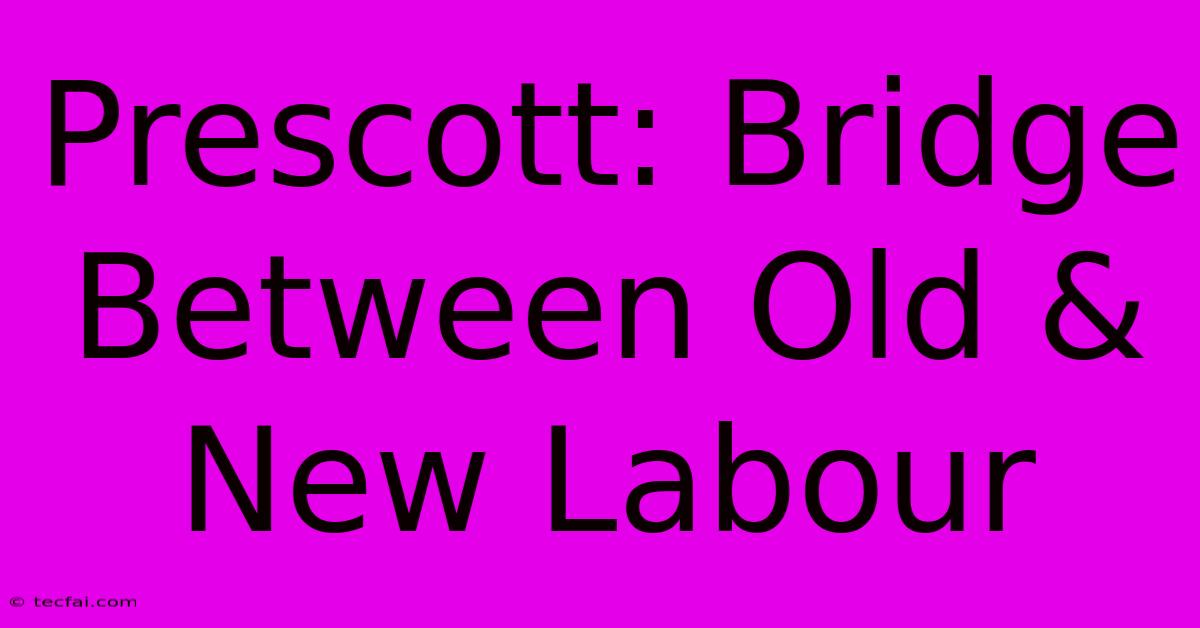Prescott: Bridge Between Old & New Labour

Discover more detailed and exciting information on our website. Click the link below to start your adventure: Visit Best Website tecfai.com. Don't miss out!
Table of Contents
Prescott: Bridge Between Old & New Labour?
John Prescott, the former Deputy Prime Minister under Tony Blair, remains a fascinating and controversial figure in British politics. His tenure, marked by both significant achievements and notable gaffes, positions him uniquely as a potential bridge between the "Old Labour" values of the past and the "New Labour" project that sought to modernize the party. But was he truly a bridge, or simply a product of his time, caught between two distinct political ideologies?
This article delves into Prescott's legacy, examining his policies, his public image, and his lasting impact on the Labour Party and British politics. We will explore whether he successfully navigated the complex transition from traditional socialist principles to the more centrist approach adopted under Blair, or whether his contradictions ultimately hindered this pivotal shift.
The "Old Labour" Roots
Prescott's background firmly rooted him in the traditional working-class values of the Labour movement. A former merchant seaman and trade union activist, his political career began within the established structures of the party. He championed policies that reflected this background, advocating for workers' rights, social justice, and investment in public services. This resonates strongly with the core values of "Old Labour," characterized by its commitment to social equality and state intervention. His strong rhetoric and forthright manner also aligned with this more traditional, less media-managed style of politics.
The "New Labour" Embrace
However, Prescott's unwavering loyalty to Tony Blair led him to wholeheartedly embrace the "New Labour" agenda. This involved a significant shift towards a more centrist platform, embracing market mechanisms and focusing on economic efficiency alongside social justice. His role as Deputy Prime Minister saw him involved in implementing policies that might have been anathema to some traditional Labour supporters, including public-private partnerships and a more cautious approach to nationalization. This demonstrated a pragmatism and adaptability that some viewed as a betrayal of core Labour principles, while others saw it as a necessary evolution.
Prescott's Policy Legacy: A Mixed Bag
Prescott's policy legacy is arguably a reflection of this tension between "Old" and "New" Labour. On one hand, he oversaw significant investment in infrastructure projects, reflecting a commitment to public works and regional development – a clear nod to "Old Labour" priorities. His focus on regeneration and tackling social deprivation also aligned with traditional Labour concerns.
However, his involvement in "New Labour" initiatives, such as the controversial Private Finance Initiative (PFI) for hospital construction, showcases the complexities of his approach. While PFI aimed to modernize healthcare infrastructure, it also drew criticism for its high costs and potential for privatization. This exemplifies the inherent tensions within the "New Labour" project itself, and Prescott's position at the heart of it.
Public Perception: A Double-Edged Sword
Prescott's public image further complicates his positioning as a bridge between the two Labour factions. His robust personality and occasional gaffes, while endearing to some, often overshadowed his policy achievements. This created a disconnect between his genuine commitment to social issues and the often-caricatured image presented by the media. The contrast between his "Old Labour" style and the more polished image cultivated by Blair and his team highlights the challenges of bridging the gap between traditional and modern political communication.
Conclusion: A Bridge, or a Crossroads?
Ultimately, whether John Prescott served as a successful bridge between "Old" and "New" Labour remains a matter of interpretation. His background and some of his policies clearly reflect "Old Labour" values, while his unwavering support for Blair and his participation in "New Labour" initiatives demonstrate his capacity for adaptation. His legacy, therefore, is not one of a simple bridging figure, but rather a complex reflection of the transformative period in British Labour politics. His story highlights the inherent challenges of navigating ideological shifts within a political party and the complexities of balancing traditional values with modern political strategies. He remains a compelling case study in the dynamics of political evolution and the challenges faced by those striving to reconcile competing ideologies.

Thank you for visiting our website wich cover about Prescott: Bridge Between Old & New Labour. We hope the information provided has been useful to you. Feel free to contact us if you have any questions or need further assistance. See you next time and dont miss to bookmark.
Featured Posts
-
Kendrick Lamar And Father John Mistys Album Releases
Nov 23, 2024
-
F1 Vegas Gp 11th Team In Talks
Nov 23, 2024
-
Meet Sharon Horgans Family
Nov 23, 2024
-
Augsburg 0 3 Bayern Harry Kanes Treble
Nov 23, 2024
-
Civil Court Mc Gregor Rape Ruling
Nov 23, 2024
